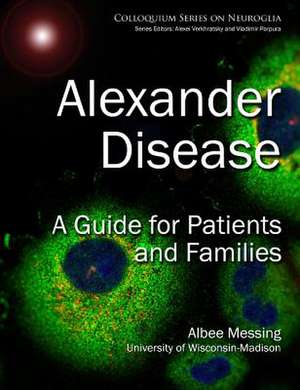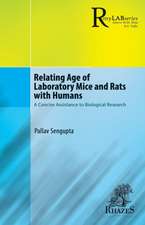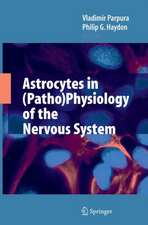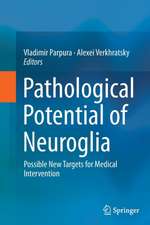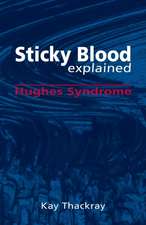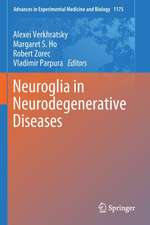Alexander Disease
Autor Albee Messing Editat de Alexei Verkhratsky, Vladimir Parpuraen Limba Engleză Hardback – 14 noi 2017
Its distinctive neuropathology consists of abundant Rosenthal fibers within astrocytes (one of the four major cell types of the central nervous system). Nearly all cases are caused by variants in the gene encoding the intermediate filament protein GFAP, but how these changes in GFAP lead to the widespread manifestations of disease is poorly understood.
Astrocytes, while discovered over a century ago, are themselves still much of a mystery. They exhibit considerable diversity, defy precise definition, and yet actively regulate many aspects of nervous system functioning.
We also have incomplete understanding of Rosenthal fibers, odd structures that contain GFAP as just one of many components. Whether they are toxic or protective is unknown. Moreover, Rosenthal fibers are not absolutely unique to Alexander disease, and are seen sporadically in a wide variety of other conditions, including brain tumors and multiple sclerosis.
GFAP is the third unknown. It is an ancient protein, arising early in the evolution of vertebrates, but its role in normal biology is still a matter of debate. Yet Alexander disease shows, without a doubt, that changing just a single of its 432 amino acids can lead to catastrophe, not just in the astrocytes where GFAP is produced but also in the other cells with which astrocytes interact.
Despite all of the unknowns, much has been learned in the past 20 years, and it is time to share this knowledge. This book is intended for recently diagnosed patients and families, as well as non-specialist researchers interested in this neurological disease. It covers historical origins, the state of current knowledge, and prospects for what lies ahead, with citations to the primary literature given throughout.
| Toate formatele și edițiile | Preț | Express |
|---|---|---|
| Paperback (1) | 197.51 lei 6-8 săpt. | |
| Morgan & Claypool Life Sciences – 14 noi 2017 | 197.51 lei 6-8 săpt. | |
| Hardback (1) | 368.31 lei 6-8 săpt. | |
| Morgan & Claypool – 14 noi 2017 | 368.31 lei 6-8 săpt. |
Preț: 368.31 lei
Preț vechi: 387.69 lei
-5% Nou
Puncte Express: 552
Preț estimativ în valută:
70.49€ • 72.81$ • 58.66£
70.49€ • 72.81$ • 58.66£
Carte tipărită la comandă
Livrare economică 25 martie-08 aprilie
Preluare comenzi: 021 569.72.76
Specificații
ISBN-13: 9781615047642
ISBN-10: 1615047646
Pagini: 104
Dimensiuni: 196 x 241 x 10 mm
Greutate: 0.41 kg
Editura: Morgan & Claypool
ISBN-10: 1615047646
Pagini: 104
Dimensiuni: 196 x 241 x 10 mm
Greutate: 0.41 kg
Editura: Morgan & Claypool
Notă biografică
Albee Messing, V.M.D., Ph.D., is Professor of Neuropathology in the Department of Comparative Biosciences, and the Director of the Waisman Center (an international center dedicated to research, education, and clinical services in the field of intellectual and developmental disabilities), at the University of Wisconsin-Madison. Dr. Messing received his undergraduate degree in biology from Yale, in 1974, and his veterinary and doctoral degrees from the University of Pennsylvania, in 1978 and 1982, respectively. He continued post-doctoral studies in experimental and clinical neuropathology at Penn under the tutorship of Nicholas K. Gonatas, M.D., and then joined the faculty at Wisconsin in 1985. He is the recipient of both the Weil and the Moore Awards from the American Association of Neuropathologists, was a Shaw Scholar of the Milwaukee Foundation, and delivered the Peter Lampert Memorial Lecture at UCSD in 2003, the Santiago Ramon y Cajal Lecture for the Spanish Neurological Society in 2010, and the Parisi Lecture for the American Association of Neuropathologists in 2013. Dr. Messing's research is directed at understanding developmental and pathologic aspects of glial cell biology. With his collaborators, he developed tools for targeting gene expression to glia in vivo, and discovered GFAP as the genetic basis for Alexander disease. For over 20 years he has led an NIH-funded research program that is focused on understanding the mechanisms of Alexander disease and developing strategies for its treatment. He is a member of the scientific advisory boards for the United Leukodystrophy Foundation and for the Charcot-Marie-Tooth Association. He has published over 160 scientific peer-reviewed papers, reviews, book chapters, and books.
